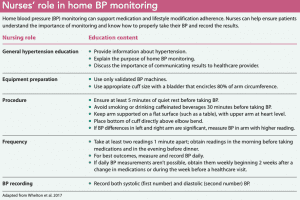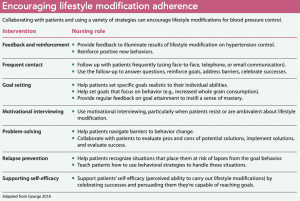Nurses’ role in medication and lifestyle modification adherence.
Takeaways:
- Nonadherence to antihypertensive medications and lifestyle modifications is a major cause of poorly controlled hypertension in older adults.
- Nurses can improve medication adherence in older adults by fostering nurse-patient relationships, implementing home blood pressure monitoring, and advocating for prescribing low-cost drugs.
- Nurses can improve adherence to lifestyle modifications by using cognitive behavioral strategies to motivate older adults, reinforce healthy behaviors, and enhance self-efficacy.
Hypertension (HTN), a treatable cause of heart attack, stroke, and premature death, is common in older adults. According to a 2018 study by Muntner and colleagues, approximately 75% of adults 65 years old and older have HTN. Its high prevalence in this population is linked to arterial stiffness associated with aging. Muntner’s study also showed that HTN in older adults is inadequately controlled, with less than 50% achieving recommended blood pressure (BP) goals. Based on the 2017 American Heart Association and American College of Cardiology guidelines, the BP goal for most older adults should be less than 130 mmHg systolic.
Nurses working in outpatient settings can apply evidence-based interventions that encourage taking medications and implementing lifestyle modifications to improve HTN control and reduce HTN-related complications.
Start with a team
Interdisciplinary team–based care that includes nurses, providers, pharmacists, and other healthcare professionals and community workers can effectively improve medication adherence. A review of 80 studies by Proia and colleagues concluded that team-based care can successfully decrease systolic (by 5.4 mmHg) and diastolic (by 1.8 mmHg) BP and improve medication adherence in 12% of patients with HTN.
Sharing HTN care responsibilities can be implemented as part of a multifaceted approach that includes a support system of providers, dietitian, pharmacist, and family for clinical decision-making, collaborating, and monitoring. As a nurse, you’re well positioned to be a leader and an integral part of the team. Your role may include providing education, following up with patients, monitoring their progress, adjusting medication dosages based on protocols, and coordinating care. Research has demonstrated that nurse-led HTN care can be effective in improving medication adherence and achieving BP goals.
Interventions to improve medication adherence
The primary cause of poor BP control is not taking prescribed medications. According to a study by Vrijens and colleagues, up to 25% of patients don’t fill their initial prescription. Many factors are associated with poor medication adherence, so solutions should be multifaceted and include performing assessments, building relationships, providing information, using home BP monitoring, suggesting medication prompts, and addressing financial concerns.
Perform assessments
Ask patients about their medication habits at every healthcare encounter. You can use a validated questionnaire (for example, the Hill-Bone validated scale) to identify barriers to adherence or ask open-ended questions to help you identify patient-specific obstacles for which tailored interventions can be applied. When evaluating medication practices, create a judgment-free environment in which patients are recognized for their achievements (such as reaching target BP goals) and encouraged to answer questions honestly. Trust is crucial for detecting and addressing nonadherence.
Ask patients about their concerns to help you understand why they aren’t taking their medication. Most patients with HTN have no symptoms, so they have little motivation to take medications, and side effects may discourage adherence. Other common factors that influence adherence are lack of knowledge about the disease and lack of trust in healthcare professionals and the healthcare system. Visual, cognitive, mobility, or swallowing impairments are common in older patients and may affect their ability to take medications as prescribed. Multiple chronic conditions may compete for the patients’ attention, and depression, social isolation, and financial challenges are common in older adults, making them less likely to engage in self-care.
Build relationships
Strategies focused on patient-nurse relationships help improve trust and, subsequently, medication adherence. Be an active listener, provide emotional support, and use clear, direct, culturally sensitive language when communicating with patients. Include patients in the decision-making process by asking for their input. In a study by Ratanawongsa and colleagues that included more than 9,000 patients, involving patients in care increased adherence by 4%; adherence was 6% higher in patients who trusted their healthcare team.
Provide information
Sharing information about HTN and explaining that it can silently inflict significant harm help improve medication adherence. The information you provide should be easy to understand. Many older adults are vulnerable to low health literacy and have limited capacity to obtain, process, and understand basic health information to help them make appropriate health decisions. When working with patients with low health literacy, modify your approach to providing information. Consider using audiovisual and interactive multimedia rather than print materials, and use teach-back methods to ensure patients understand what you’ve explained.
Use home BP monitoring
Evidence from several robust studies suggests that home BP monitoring combined with support significantly increases adherence to antihypertensive therapies and improves BP control. The impact of home monitoring is greatest when patients are educated about the correct method for taking their BP. In addition, ask patients to periodically bring the home machine to healthcare appointments so it can be checked for accuracy. To increase the usefulness of home BP monitoring, encourage patients to report results to their providers. (See Nurses’ role in home BP monitoring.)


Suggest prompts
Some patients, especially older adults, may have difficulty remembering to take BP medications. Several patient-reminder systems exist to improve adherence, including pill organizers and daily pill dispensers. In an analysis of 37 studies performed by Ruppar and colleagues, daily pill dispensers increased the likelihood of adherence by 30%.
Encourage patients to use charts or pill organizers and suggest that they incorporate medication taking into their daily routine; ask family members to help with reminders. Also tell them about phone apps and alarms they can use.
Consider speaking with the healthcare provider about simplifying medication regimens, either by prescribing less frequent dosing (once daily) or using combination drug therapy. Several fixed-dose combination drugs are available, and research shows that patients receiving single-pill antihypertensive combinations are more likely to take their medications as prescribed than those given the same medications as several individual pills.
Address financial concerns
Medication cost is a significant barrier to adherence, especially among older adults living on a fixed income. Efforts to minimize out-of-pocket costs, especially for asymptomatic conditions such as HTN, are important. Less-expensive, generic options are available within each class of antihypertensive drugs; partner with healthcare providers and pharmacists, and advocate for prescribing these medications. Big chain retail stores frequently have low prices on many generic formulations, so encourage patients to find out if their medications are sold at lower prices. Resources such as GoodRx or Blink Health offer free online resources that monitor prescription drug prices and offer discounts on medications within the United States.
Interventions to improve adherence to lifestyle modifications
Several lifestyle modifications—including weight loss, the DASH (Dietary Approaches to Stop Hypertension) diet, sodium reduction, and increased physical activity—can help lower BP. These changes may be sufficient to prevent HTN in people at risk and improve BP control in those who have HTN. However, despite proven benefits of nonpharmacologic treatments, adopting and maintaining healthy lifestyle changes can be difficult, especially for older adults, who may face additional barriers, such as social isolation, poor health, and reduced mobility. Many socioeconomically disadvantaged elderly patients live in neighborhoods that may not be conducive to exercise because of high traffic, poor lighting, infrastructure deterioration, and high crime rates. Lack of access to fresh produce at affordable prices is an additional barrier for low-income older adults. Assess for these factors as you make recommendations for lifestyle modifications.
Cognitive-behavioral strategies are a core element of behavioral change in all population groups, including older adults. Combining various interventions (for example, feedback and reinforcement, frequent follow-up, goal setting, motivational interviewing, problem-solving, relapse prevention, and self-efficacy) is more effective for promoting and sustaining lifestyle modifications than a single strategy, especially if the interventions are tailored to a patient’s cultural context. A meta-analysis by Ratanawongsa and colleagues of 16 trials that used culturally sensitive multicomponent interventions demonstrated positive changes in dietary and/or physical activity behavior among diverse groups. (See Encouraging lifestyle modification adherence.)


Feedback and reinforcement
Social support is important to sustaining lifestyle modifications. Family members can help with encouragement and also by adjusting their health behaviors (such as changing to low-fat family meals). You can share and explain the results of patients’ lifestyle changes on HTN control to help reinforce positive behaviors.
Frequent contact
Frequent follow-up (biweekly or monthly) can improve patient adherence to lifestyle modifications, boost motivation, reinforce healthy behavior, and establish trust with you and other members of the care team.
Goal setting
Collaborate with patients to develop specific realistic goals (such as quitting smoking, increasing fruit and vegetable intake, or walking 30 minutes three times a week). Provide feedback and positive reinforcement when patients meet their goals.
Motivational interviewing
Motivational interviewing is an effective way to improve adherence to lifestyle modifications. Several studies demonstrate that it can help patients increase physical activity and decrease body mass index. (See Motivational interviewing.)
The goal of motivational interviewing is to determine a patient’s readiness for change and establish a collaborative relationship to assist in that change. During the interview:
- listen reflectively
- elicit the patient’s perspective on making lifestyle changes
- express acceptance and support for the patient’s challenges and successes
- affirm the patient’s freedom to choose the best course of action
- reinforce the patient’s self-motivational statements that promote positive change.
Several print and electronic resources are available to help you learn more about motivational interviewing, including motivationalinterviewing.org/motivational-interviewing-training and myamericannurse.com/motivational-interviewing.
Problem solving
When patients encounter barriers to lifestyle modifications, help them find ways to surmount them. For example, suggest they make a pro-and-con solutions list, implement a solution, and then evaluate whether it worked.
Relapse prevention
Help patients recognize situations that place them at risk for diverging from their dietary or physical activity goals (for example, having guests over for dinner, celebrating holidays, travelling) and how to use behavioral strategies, such as meal planning or increased exercise time and intensity, to plan these circumstances. Spouse and family support become particularly important to provide practical and motivational help in these situations. Part of relapse prevention also should include letting patients know it’s acceptable to deviate occasionally from the goal behavior. For example, eating salty food or missing an exercise class doesn’t negate all of the previous positive steps they’ve taken.
Self-efficacy
Evidence indicates that self-efficacy (an individual’s perception of his or her ability to change) enhances lifestyle modification adherence and yields favorable health outcomes in diet and physical activity. You can enhance self-efficacy by working with patients to successfully achieve a realistic goal (for example, substituting fruit for a high-calorie dessert or walking to a destination instead of driving) and boosting their confidence by celebrating successes.
Make a difference
Many effective strategies exist to improve patient adherence to antihypertensive medications and lifestyle changes, which in turn can reduce patients’ risk of stroke, myocardial infarction, and other cardiovascular conditions. You can make a difference by partnering with patients to help them help themselves improve adherence and achieve better health outcomes.
The authors are from the Rutgers School of Nursing in Newark, New Jersey. Carol Dinnocenzio recently graduated with her doctorate in nursing practice. Irina Benenson is an assistant professor in the Division of Advanced Nursing Practice.
References
Benenson I, Waldron FA, Bradshaw MJ. Treating hypertension in older adults: Beyond the guidelines. J Am Assoc Nurse Pract. 2020;32(3):193-9.
George MG. Understanding and improving medication adherence. In: Bakris GL, Sorrentino M, eds. Hypertension: A Companion to Braunwald’s Heart Disease. 3rd ed. Philadelphia: Elsevier; 2018:452-8.
Muntner P, Carey RM, Gidding S, et al. Potential US population impact of the 2017 ACC/AHA high blood pressure guideline. Circulation. 2018;137(2):109-18.
Proia KK, Thota AB, Njie GJ, et al. Team-based care and improved blood pressure control: A community guide systematic review. Am J Prev Med. 2014;47(1):86-99.
Ratanawongsa N, Karter AJ, Parker MM, et al. Communication and medication refill adherence: The diabetes study of northern California. JAMA Intern Med. 2013; 173(3):210-8.
Ruppar TM, Dunbar-Jacob JM, Mehr DR, Lewis L, Conn VS. Medication adherence interventions among hypertensive black adults: A systematic review and meta-analysis. J Hypertens. 2017;35(6):1145-54.
Tucker KL, Sheppard JP, Stevens R, et al. Self-monitoring of blood pressure in hypertension: A systematic review and individual patient data meta-analysis. PLoS Med. 2017; 14(9):e1002389.
Vrijens B, Antoniou S, Burnier M, de la Sierra A, Volpe M. Current situation of medication adherence in hypertension. Front Pharmacol. 2017;8:100.
Whelton PK, Carey RM, Aronow WS, et al. 2017 ACC/AHA/AAPA/ABC/ACPM/AGS/APhA/ASH/ASPC/NMA/PCNA guideline for the prevention, detection, evaluation, and management of high blood pressure in adults: Executive summary: A report of the American College of Cardiology/American Heart Association Task Force on Clinical Practice Guidelines. Hypertension. 2018;71(6):1269-324.
Xie L, Frech-Tamas F, Marrett E, Baser O. A medication adherence and persistence comparison of hypertensive patients treated with single-, double- and triple-pill combination therapy. Curr Med Res Opin. 2014;30(12):2415-22.


















